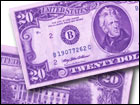
NEW YORK (CNN/Money) - The vaunted American greenback is about to get a bit more colorful.
The Treasury Department and the Federal Reserve said Thursday that the first of the next generation of redesigned U.S. paper currency will be hitting the streets as early as the fall of 2003, complete with what are described as "subtle background colors."
The $20 bill, the most widely used denomination, will be the first to bow, followed by the $100 and $50 bills in a year to 18 months, the agencies said.
Dawn Haley, spokeswoman for the Treasury's Bureau of Engraving and Printing, said the inclusion of the colors will be "a noticeable change." She said the colors will show up more as a "tint" underlying the current printing on the front and back of the bills, rather than overshadowing it.
The redesign comes only a few years after the end of a previous design cycle. The $100 bill was last redesigned in 1996, with the addition of new security features and the off-center, larger portrait of Benjamin Franklin. The similarly redesigned $20 bill made its debut in 1998, while new $5 and $10 notes were issued in 2000. Redesigning the $5 and $10 bills this time is still under consideration, though there are no plans to give a face-lift to the $1 or $2 notes.

Haley said officials are getting the word out now about the looming change in an attempt to work with the vending machine, gaming and mass transit industries, whose operations could be affected.
"This time, we're trying to reach the second-, third- and fourth-tier users of the currency," Haley said.
By saying the $20 note will be the first to be changed, users can start making preparations, she added.
Details of the new design remain sketchy. While the bills will continue to use the same portraits and buildings as the current bills, Haley said they will be presented slightly differently. The new design for the $20 bill will not be unveiled until six to nine months before it goes into circulation, she said.
The need for the redesign stems from an attempt to keep pace with technological changes that make counterfeiting easier than in the past. The increased availability and power of computers, printers and scanners to create good-looking fakes has heightened the potential for counterfeits in recent years.
The Secret Service said 39 percent of the estimated $47.5 million in fake money in circulation in 2001 was computer-generated, compared with only 0.5 percent in 1995.
The use of colors is not itself a security feature, the agencies said, but it will allow anti-counterfeiting measures to be added later. It also will help consumers identify various denominations.

by staff and wire reports
|

